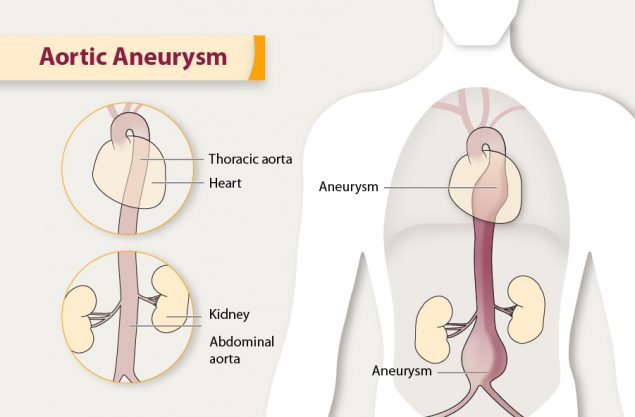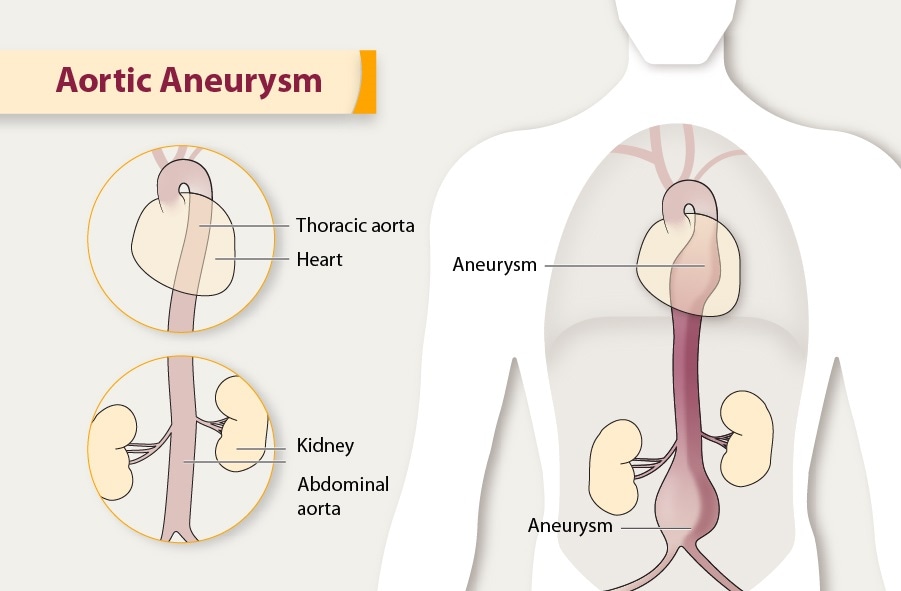Aortic Aneurysm
What is aortic aneurysm?
An aortic aneurysm is a balloon-like bulge in the aorta, the large artery that carries blood from the heart through the chest and torso.
Aortic aneurysms can dissect or rupture:
- The force of blood pumping can split the layers of the artery wall, allowing blood to leak in between them. This process is called a dissection.
- The aneurysm can burst completely, causing bleeding inside the body. This is called a rupture.
- Dissections and ruptures are the cause of most deaths from aortic aneurysms.
Facts About Aortic Aneurysm in the United States
- Aortic aneurysms or aortic dissections were the cause of 9,904 deaths in 2019.1
- In 2019, about 59% of deaths due to aortic aneurysm or aortic dissection happen among men.1
- A history of smoking accounts for about 75% of all abdominal aortic aneurysms.2
- The U.S. Preventive Services Task Force recommends that men 65 to 75 years old who have ever smoked should get an ultrasound screening for abdominal aortic aneurysms, even if they have no symptoms.3
What are the types of aortic aneurysm?
What are the risk factors for aortic aneurysm?
Diseases and unhealthy behaviors that damage your heart and blood vessels also increase your risk for aortic aneurysm. Smoking is the most important behavior related to aortic aneurysm.
Other factors include
Some inherited connective tissue disorders, such as Marfan syndrome and Ehlers-Danlos syndrome, can also increase your risk for aortic aneurysm. Your family may also have a history of aortic aneurysms that can increase your risk.
How are aortic aneurysms treated?
The two main treatments for aortic aneurysms are medicines and surgery. Medicines can lower blood pressure and reduce risk for an aortic aneurysm. Surgery can repair or replace the affected section of the aorta.
More Information
- State and Local Public Health Actions
- Million Hearts®
- MedlinePlus
- National Heart, Lung, and Blood Institute
- American Heart Association
References
- Centers for Disease Control and Prevention, National Center for Health Statistics. About Multiple Cause of Death, 1999–2019. CDC WONDER Online Database website. Atlanta, GA: Centers for Disease Control and Prevention; 2019. Accessed February 1, 2021.
- Norman PE, Curci JA. Understanding the effects of tobacco smoke on the pathogenesis of aortic aneurysm. Arterioscler Thromb Vasc Biol. 2013;33(7):1473–7.
- U.S. Preventive Services Task Force. Rockville, MD: U.S. Preventive Services Task Force; 2014. Accessed February 16, 2018.
- Clouse WD, Hallett JW Jr., Schaff HV, Gayari MM, Ilstrup DM, Melton LJ 3rd. Improved prognosis of thoracic aortic aneurysms: a population-based study.JAMA. 1998;280(22):1926–9.
- Guirguis-Blake J, Wolff TA. Screening for abdominal aortic aneurism. Am Fam Physician. 2005;71(11):2154–5.
- Creager MA, Loscalzo J. Diseases of the aorta. In: Fauci AS, Longo DL, Kasper D, Braunwald E, Jameson JL, Loscalzo J, Hauser SL, eds. Harrison’s Principles of Internal Medicine. 17th ed. Columbus, OH: McGraw-Hill; 2008:1563–7.


